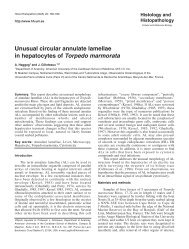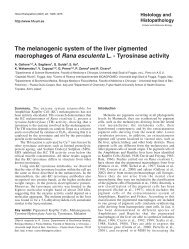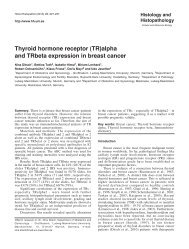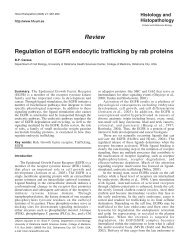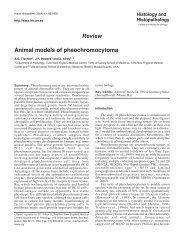Review Multicolor FISH probe sets and their applications
Review Multicolor FISH probe sets and their applications
Review Multicolor FISH probe sets and their applications
Create successful ePaper yourself
Turn your PDF publications into a flip-book with our unique Google optimized e-Paper software.
230<br />
<strong>Multicolor</strong> <strong>FISH</strong> <strong>probe</strong> <strong>sets</strong><br />
This basic m<strong>FISH</strong> <strong>probe</strong> set (Fig. 1) has been<br />
modified either by molecular changes in the <strong>probe</strong>s<br />
themselves or by addition of supplementary <strong>probe</strong>s. The<br />
so-called IPM-<strong>FISH</strong> (= IRS-PCR multiplex <strong>FISH</strong>)<br />
method uses whole chromosome painting <strong>probe</strong>s which<br />
are modified by an interspersed polymerase chain<br />
reaction (IRS), which leads to a 24-color-<strong>FISH</strong> painting<br />
plus an R-b<strong>and</strong>-like pattern (Aurich-Costa et al., 2001).<br />
For special questions other <strong>probe</strong>s were added to the<br />
basic 24-color-<strong>FISH</strong> <strong>probe</strong> set, like single copy <strong>probe</strong>s<br />
(e.g. <strong>probe</strong> for human papillomavirus (Szuhai et al.,<br />
2000, 2001; Brink et al., 2002) or subtelomeric <strong>probe</strong>s<br />
(Tosi et al., 1999)), chromosome-region-specific <strong>probe</strong>s<br />
(e.g. a <strong>probe</strong> for the short arm of all acrocentric<br />
chromosomes (Mrasek et al., 2001) – Fig. 1) or<br />
chromosome-arm-specific <strong>probe</strong>s for all human<br />
chromosomes (42-color-<strong>FISH</strong> (Wiegant et al., 2000;<br />
Karhu et al., 2001; Brink et al., 2002; Liehr <strong>and</strong><br />
Claussen, 2002).<br />
m<strong>FISH</strong> b<strong>and</strong>ing <strong>probe</strong> <strong>sets</strong><br />
<strong>FISH</strong> b<strong>and</strong>ing <strong>probe</strong> <strong>sets</strong> are defined as “any kind of<br />
<strong>FISH</strong> technique, which provides the possibility to<br />
simultaneously characterize several chromosomal<br />
subregions smaller than a chromosome arm - excluding<br />
the short arms of the acrocentric chromosomes; <strong>FISH</strong><br />
b<strong>and</strong>ing methods fitting that definition may have quite<br />
different characteristics, but share the ability to produce<br />
a DNA-specific chromosomal b<strong>and</strong>ing” (Liehr et al.,<br />
2002). In the following paragraphs the available m<strong>FISH</strong><br />
b<strong>and</strong>ing <strong>probe</strong> <strong>sets</strong> are listed according to <strong>their</strong> quality of<br />
resolution.<br />
1. The cross-species color b<strong>and</strong>ing (Rx-<strong>FISH</strong>) or<br />
Harlequin-<strong>FISH</strong> <strong>probe</strong> set (Fig. 2) provides the lowest<br />
resolution of 80-90 b<strong>and</strong>s per haploid human karyotype<br />
(Müller <strong>and</strong> Wienberg, 2000). The <strong>probe</strong> set consists of<br />
flow-sorted gibbon chromosomes, which are labeled<br />
with three different fluorochromes (Müller et al., 1998).<br />
A set of 110 human-hamster somatic cell hybrids, split<br />
into two pools <strong>and</strong> labeled with two fluorochromes<br />
(Müller et al., 1997), leads, when hybridized to human<br />
chromosomes, to about 100 “bars” on each chromosome.<br />
This pattern has been called ‘somatic cell hybrid-based<br />
chromosome bar code’. A combination the Rx-<strong>FISH</strong><br />
<strong>probe</strong> set with the 110 somatic cell hybrid <strong>probe</strong>s results<br />
in 160 chromosome-region-specific DNA-mediated<br />
b<strong>and</strong>s in human karyotypes (Müller <strong>and</strong> Wienberg, 2000;<br />
Müller et al., 2002).<br />
2. An approach called SCAN (= spectral color<br />
b<strong>and</strong>ing) has been described exemplarily for one<br />
chromosome up to present. 8 microdissection libraries<br />
were created along chromosome 10 with the aim of<br />
obtaining a b<strong>and</strong>ing pattern similar to the GTG-b<strong>and</strong>ing<br />
at the 300 b<strong>and</strong> level (Kakazu et al., 2001).<br />
3. A chromosome can be characterized as well by a<br />
specific signal pattern produced by region-specific YAC<br />
(= yeast artificial chromosomes) clones. The first<br />
attempts to label each chromosome by subregional DNA<br />
<strong>probe</strong>s in different colors were performed by the groups<br />
of David Ward (Lichter et al., 1990) <strong>and</strong> Thomas Cremer<br />
(Lengauer et al., 1993). A YAC-based chromosome bar<br />
code has been especially created for chromosome 12 but<br />
not for the entire human karyotype yet (for review see<br />
(Liehr <strong>and</strong> Claussen, 2002, 2002a)). A resolution of up<br />
to 400 b<strong>and</strong>s can be achieved, depending on the number<br />
of applied <strong>probe</strong>s.<br />
4. The aforementioned IPM-<strong>FISH</strong> approach (Aurich-<br />
Costa et al., 2001) can be categorized as an m<strong>FISH</strong><br />
b<strong>and</strong>ing <strong>probe</strong> set, as well. A resolution of about 400<br />
b<strong>and</strong>s per haploid karyotype can be attained, dependent<br />
on the chromosome quality.<br />
5. The high-resolution multicolor-b<strong>and</strong>ing (MCB)<br />
technique, based on overlapping microdissection<br />
libraries producing fluorescence profiles along the<br />
human chromosomes was described first on the example<br />
Fig. 1. 25-color <strong>FISH</strong> karyogram of a normal female metaphase (Mrasek<br />
et al., 2001). Like in M-<strong>FISH</strong> or SKY each chromosome is labeled in a<br />
different (pseudo-)color. Additionally to the 24 human whole<br />
chromosome painting <strong>probe</strong>s (as it is a female no Y-chromosome is<br />
present), a <strong>probe</strong> specific for all short arms of human acrocentric<br />
chromosomes, i.e. #13, #14, #15, #21, <strong>and</strong> #22 (marked by<br />
arrowheads), is included. The <strong>probe</strong> is microdissection-derived <strong>and</strong> has<br />
been called midi54 – in the legend for the pseudocolors for each<br />
individual chromosome the 25th color for midi54 is abbreviated as “M”.<br />
Fig. 2. Rx-<strong>FISH</strong> performed on a normal female metaphase.<br />
Chromosomes can be distinguished based on three fluorochromes <strong>and</strong><br />
~90 b<strong>and</strong>s per haploid karyotype. However, e.g. chromosomes 21, 22 or<br />
X are not divided into subb<strong>and</strong>s in that assay.



